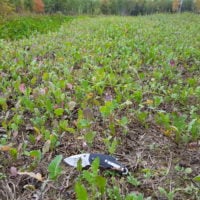I give the same little “planting instructions” speech to every customer who buys seed in person and every planting instruction sheet included in my seed blends contains the same warning: Do NOT spread more than the recommended amount of seed in a given area! Over-planting is bad, essentially.
Well, in case you’re wondering, here’s a good illustration of WHY you don’t want to be that guy or gal. The attached photo shows my Brassicas Bender blend of rape, forage radish, sugar beets, and turnips.
If it were properly seeded, the plants should be about 6 inches apart and they should be huge, the greens should be knee high at the point when this picture was taken (September 15). There should be softball-sized turnips and radish that look like large white carrots.
But as you can see, the plants are close together like a lawn. Look at those little marble sized turnips–ugh! That’s my pocket knife laying in there for scale. The plants are totally stunted and they will not recover even though ample fertilizer has been added to this plot. There is no recovery from this mistake except to learn from it for next year.
Now who’s the dolt that ignored the dire warning not to overplant? Well, it’s me, thanks for asking.
In my defense, this was not a case of ignoring my own advice. I bought a new broadcast spreader last fall, but unfortunately, I forgot that the seeder settings I had written down in my planting log were for the OLD seeder, not the new. So I planted one complete pass before I noticed I was blowing way too much seed out and by then it was too late. You can’t pick it up after it hits the dirt.
So this wasn’t a total loss because I was able to correct the setting and plant the rest of the 3-acre plot correctly. But I wanted to share this because it’s a good illustration of WHY you don’t want to spread more than the recommended amount of seed on your plots. A little or a lot of extra seed is WORSE than not enough!
Since most of us food plotters use broadcast seeders, here’s how to avoid being that guy (or gal):
1. Calibrate your seeder using the manufacturer’s procedure.
2. It is ALWAYS better to set your seeder at half of the recommended seeding rate and then cover the plot twice. This will also expose any errors in calibration.
For example, if you have a bag of seed that should cover 1/2 acre and you cover the plot once (applying at half the recommended rate), and then you go over the plot a second time and only have enough seed to re-cover about 3/4 of the plot a second time, you know your seeder setting is STILL too heavy. Dial it back next season, but in the meantime at least you haven’t massively overseeded the whole plot, but you would have if you would have tried to seed the whole thing in one pass.
3. If at all possible, have a second person present when you seed a plot so they can “mark” the outer edge of the broadcaster’s throw on each pass. I have about a dozen orange golf balls that I have somebody walk along and drop to mark the outer edge of the “throw” as we go along. Then when I turn around to do the next pass, these markers give me a visible “path” to plant the next pass. This helps on the next pass by avoiding too much overlap and it helps to avoid missing patches.
4. Keep records! Start a log book or use the awesome software from my friends at FarmLogs.com, but record EVERYTHING. Which seeder did you use, seed brand, seeder setting, planting time, conditions and last but not least, add a heading for things to do differently NEXT YEAR.
Hope this helps everyone.
Grouse
